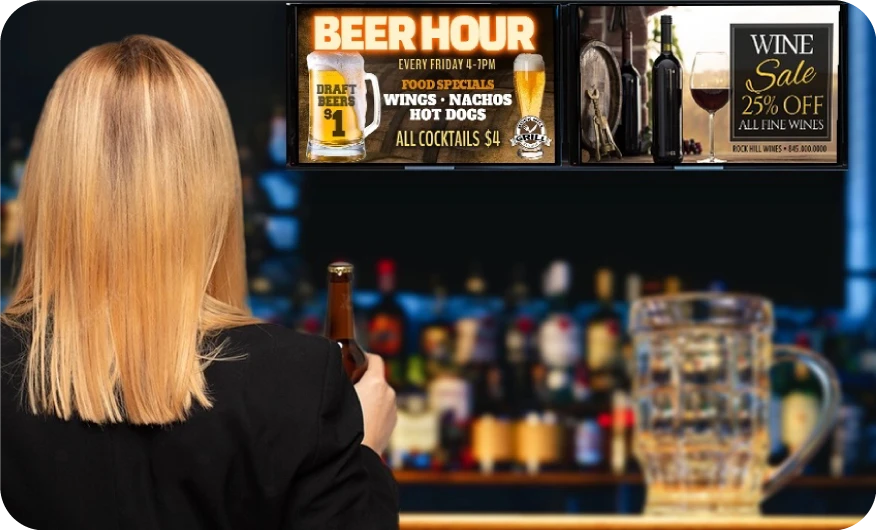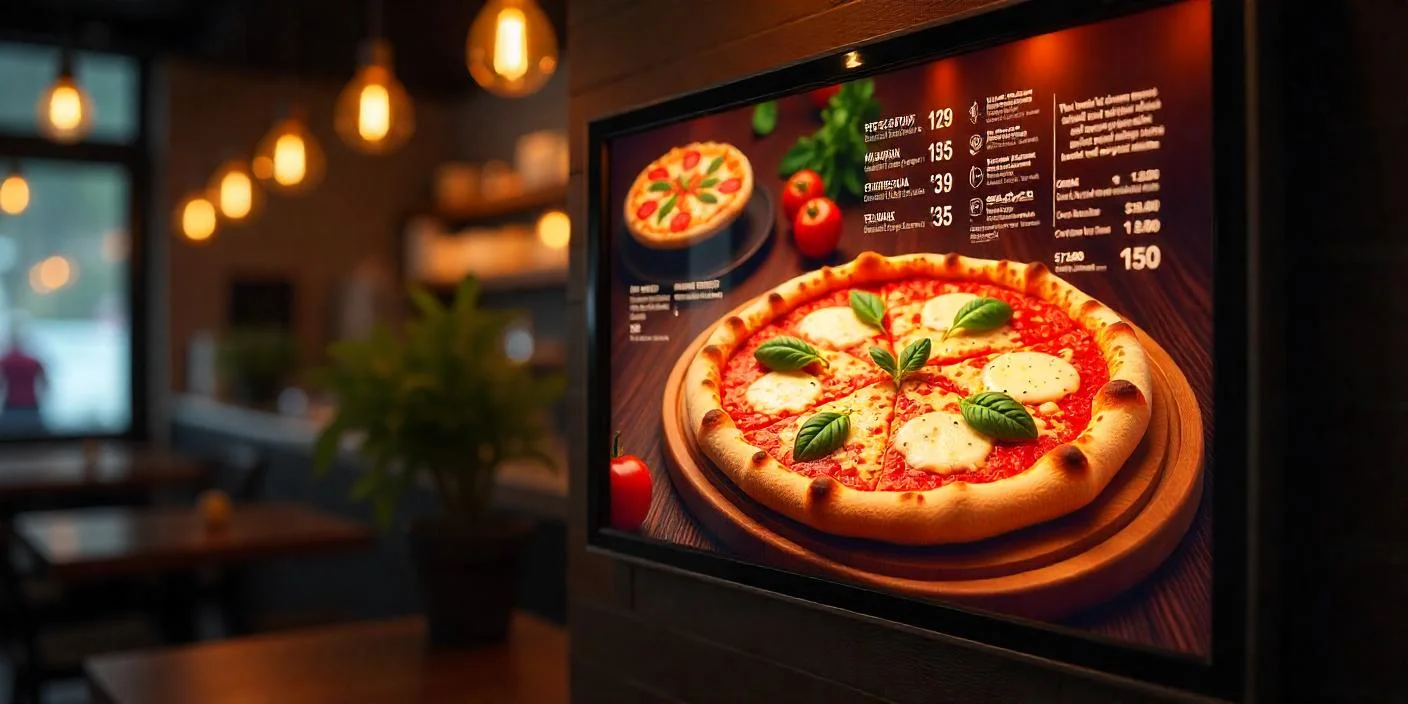In the busy world of hospitality nowadays, restaurant and bar signage is not a form of decoration; it is your first line of marketing. You could be a casual brewpub or a high-end steakhouse, but the digital signage for bars or digital signage for restaurants that fit your operation catches the eye, conveys the values of your brand, and moves customers with ease between curb and counter. With the use of interactive digital signage software, digital menu board displays, and full-service digital signage solutions, Nento assists you in the creation of a seamless digital signage solution that will convert casual browsers into repeat customers.
Key Objectives of Your Signage Strategy
Attract from Foot Traffic
A high-bright screen and animated graphics for outdoor restaurant and bar signage installation are impossible to overlook. It may be a programmable LED marquee that says Happy Hour or dynamic digital signage that presents a bar display that has live music, but either way, bright and colorful images attract new customers out of the street.
Spread Specials & Events
Restaurants and bars can quickly promote daily specials, seasonal drinks, or themed parties with a digital menu board. A digital signage solution will make sure that the guests view the latest offers and will automatically be displayed with a brunch menu during the morning and drink specials in the evening.
Increase Atmosphere & Interaction
Interactive digital signage software makes patrons interact. Touchscreen kiosks allow them to browse through beer selections with tasting notes, play with wine pairings, or even play trivia games about your establishment itself, all the time reinforcing the unique personality of the place and keeping people entertained.
Why Signage Matters in Restaurants and Bars
The best restaurant and bar signage creates an atmosphere even before customers have entered the building. An attractive digital display is an indication of professionalism, modernity, and quality. Signage can influence how customers think, make their lives easier by guiding them to the entrance of the bar and display plated food on a digital menu board, and can even result in higher sales through better accuracy of orders and an up-selling percentage.
The Evolution to Digital Signage for Bars and Restaurants
Chalkboards and static signs have been replaced by very versatile digital signage in restaurants and bars. Digital signage services offered today need to be dynamic, scalable and cloud based. Manage and update your content in real-time with remote updates, instantly change menus and promotions, and send event alerts without printing. Digital menu board technology is embedded in the Nento platform so that you can control all of it via a single, easy-to-use dashboard.
Interactive Digital Signage: Enhancing Customer Experience
Make passive screens interactive by harnessing interactive digital signage software. An interactive digital beer board in a bar environment can show origin stories, tasting notes, and live sporting scores and also engage customers to promote future upselling activity. At restaurants, the customers personalize orders on digital menu board kiosks, scan allergy details, and watch chef-selected videos- delivering unforgettable, interactive experiences that make people come back.
Digital Menu Boards: A Game Changer for Hospitality
Modern restaurant and bar signage is based on digital menu board displays. Nento boards facilitate dayparting whereby there is an automatic switching of menus between breakfast, lunch and evening cocktail menus. Integrated POS connectivity ensures that the price is always correct, and animated promotions stimulate impulse purchases. By excluding the use of printed menus, you will not only save on recurrent expenses and prevent errors in the orders, but you will also enhance the guest experience and your bottom line.
All-in-One Digital Signage Services by Nento
Nento does not only sell software, but a complete range of digital signage services customized to hospitality:
- Restaurant and bar templates: Professionally designed restaurant and bar menu, event promotion and social media wall templates.
- Scalable digital signage player software: This software can be used to play reliably on Android, Windows, or webOS and has consistent performance.
- Cloud-based content management: Update screens remotely using any device and ensure your digital signage solution is current and timely.
- POS & kitchen display integration: Automate orders, pricing and inventory, as well as streamline front and back-of-house operations.
Choosing the Right Digital Signage Solution
Test your restaurant and bar digital signage on reliability, scalability, and ease of use. The platform of Nento is created to scale: one digital menu board can be installed, and the rest can be extended to drive-thru displays or outdoor digital screens in bar units. Control every display over a single dashboard, plan content updates ahead of time, and leverage analytics to refine your messaging using engagement insight.
Tailored Signage for Every Style of Venue
Each venue is different. Nento restaurant and bar signage offerings:
- Indoor / Outdoor Screen Support: Our hardware is weatherproof and vandal-resistant, including bar back walls, patio areas and more.
- Branded Experiences: Use your logo, brand colors and fonts to customize digital signage solutions to make them look consistent.
- Multi-Location Control: Manage screens in multiple locations- perfect for expanding bar chains or restaurant groups.
Implementation Steps for a Flawless Rollout
Plan Your Layout
Determine areas with a lot of traffic, e.g. entrances, order counters, and lounge areas, and select proper screen sizes. Make sure your bar display digital signs are visible at strategic locations.
Creating Interesting Content
Use the Free templates for restaurants offered by Nento to create aesthetically appealing menu slides, event promoters and social media feeds. Get attention using motion graphics and bold headings.
Train Your Personnel
Offer short training sessions to refresh the interactive digital signage software, schedule promotions and do basic troubleshooting- this will enable your team to keep the content fresh and free of errors.
Empowering Resellers with Nento
Reseller digital signage program Nento Marketing agencies and IT providers can participate in the Nento reseller digital signage program to provide white-label solutions under their brand. Get the benefit of bulk rates, special support, and smooth backend administration to enable restaurants and bars to implement the latest signage technology at minimal investment.
Why Choose Nento?
Nento is unique in providing hospitality-specific digital signage services that are simple yet powerful. Regardless of whether you are a single-location cafe or a chain of bars, our turnkey digital signage platform provides you with all the tools required to impress your visitors, automate processes, and innovate to achieve growth.
Ready to Transform Your Venue with Nento?
Stay away from outdated static signs. Take your restaurant and bar signage to a new level with Nento digital signage services, interactive digital signage software, and digital menu board services. Talk to us now and get a personalized demo and see how Nento can turn your hospitality into a destination.
FAQs: Common Questions About Restaurant and Bar Signage
What businesses can benefit from restaurant and bar signage?
Digital signage services are valuable in bars, restaurants, cafes, lounges, nightclubs and hotel dining areas to advertise menus, specials and events.
Can I update signage content remotely?
Yes, you can manage it all with the Nento cloud-based digital signage system and control all screens wherever you are, so your digital menu board is always current.
Is the software beginner-friendly?
Absolutely. With our interactive digital signage software, we have drag-and-drop editing, easy scheduling and pre-built Free templates to fit the restaurant industry, so setup is fast and simple.
Do I need to hire a designer?
No. The large library of templates and the easy-to-use editor allow building signage at a professional level without any design expertise.
How do I get started?
Subscribe to Nento, select your package, and attach your screens (or leave media players to us), and you can begin personalizing content. You will be assisted through all the steps by our support team.








